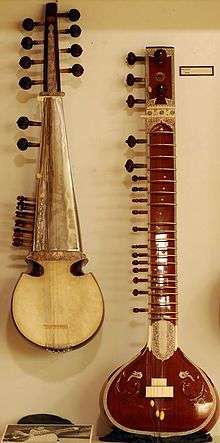Seni rebab
The Seni rebab is a plucked string instrument said to have been developed by, and to have taken its name from, the notable musician Tansen in the time of the emperor Akbar the Great. Today it is most associated with Sikh music.
Three types of Sikh musician - rababis, ragis and dhadhis - flourished during the period of the Sikh gurus.
Rababi
Main article: Rababi
Guru Nanak started the rababi tradition by engaging Bhai Mardana as his accompanist. The Muslim singers formerly called mirasis, Nanak called "rababis", because they played on the rabab or rebec. Some notable rababis after Mardana were his son Shahjada, Balwand and Satta, Babak, son of Satta, Chatra, son of Babak, and Saddu and Baddu. Rababis used to perform kirtan regularly at Amritsar before the partition in 1947, after which the rababis migrated to Pakistan.
The last of the line of rababis was Bhai Chand. During the 20th century CE the instrument's use in Sikh kirtan was eclipsed by the harmonium but it has been revived.
